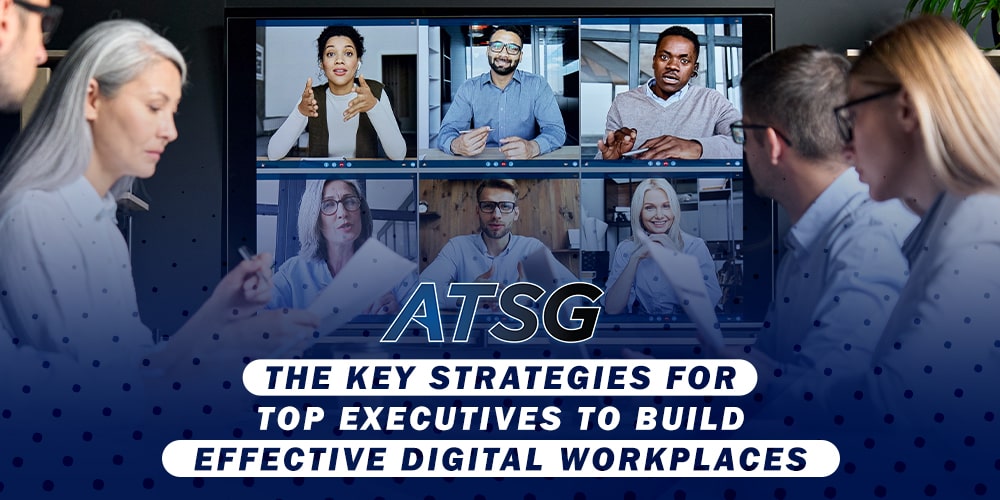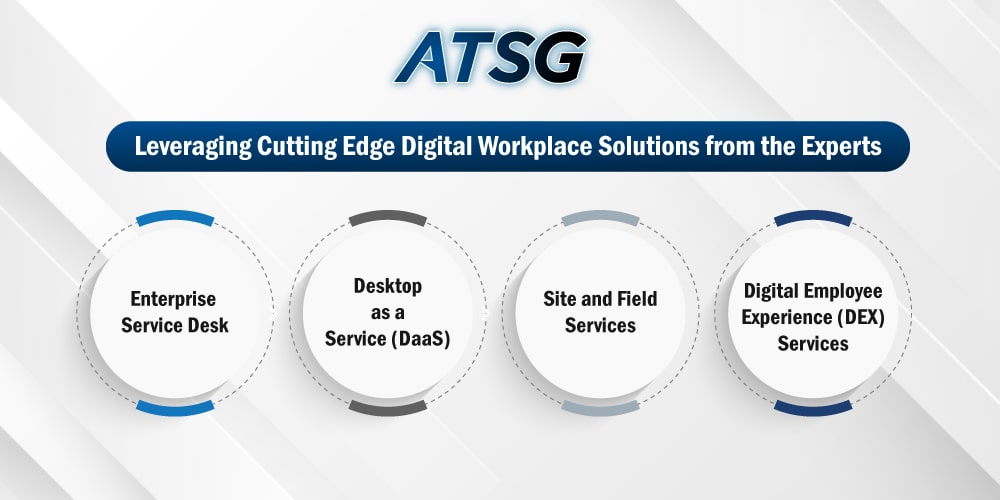Driven by the advancements of digital platforms, organizations have been compelled to transform their digital work environments as well. The changes that were rapidly implemented due to COVID-19 have revolutionized work. Organizations around the world have begun to adopt flexible and innovative methods to drive more employee productivity and satisfaction.

The goal is to adopt a digital workplace that encourages a positive employee journey, based on effective communication, collaboration, and productivity strategies. Executives now believe it’s essential to encourage and embrace effective digital changes at every tier of the organization.
What is a Digital Workplace?
Digitization is the process of leveraging a range of technology systems and software programs to develop algorithms and models that automate processes. These initiatives result in cutting costs, supporting better decision-making, enabling stronger performance, and delivering deeper customer insights. Technologies and platforms that enable digitization include automated systems, Internet of Things (IoT) capabilities, and artificial intelligence (AI), among other platforms and resources.
The trends driving digital workplaces began way before the pandemic struck. The emergence of cloud services, software as a service (SaaS), artificial intelligence (AI), and internet of things (IoT) technology catalyzed the process of digital transformation.
The introduction to remote and distributed workforces is built upon the framework that is integrated with today’s digital workplace. The ever-evolving nature of the digital workplace comes with major responsibility shifts, advanced technology tools, and un-rivaled agility.
The Impact of Digital Workplace on Businesses
Effectively implementing digital tools can be initially challenging. Therefore, to digitize successfully, C-Level executives need to develop strategies that guide the implementation of these capabilities, delegate tasks and ensure seamless transitions. For businesses to succeed, the C-suite executives need to integrate the concept by bringing digital capabilities, and their digital strategy to encompass all aspects of the business.
Any single facet of an organization cannot enjoy digital fluency and actionable information without all departments being in sync. Digital competencies should be built around an all-encompassing, corporate-wide mandate that covers all departments and all functional areas of a business. Digital is not a destination; it’s rather an ongoing journey that demands the un-wavering commitment of a determined leader, and a refined digital strategy.
Conforming to Modern Digital Environments
The new digital workplace is far-reaching and includes traditional technologies, agile hierarchies, virtual communication tools, and more. It is important to remember in this shift to digital experiences, that companies are made up of people, and also exist to serve people. Adapting to digital changes is becoming a business imperative, as organizations can no longer go back to the ‘old ways’ of working.
Employees and recruits now look for opportunities in remote work environments. Enterprises need to assemble robust solutions and flexible digital workplaces to meet employee needs and satisfaction.
With digital transformation, organizations have to adopt a people-centric approach toward workplaces. To provide what employees need, and optimize work productivity; digital workplaces need to be central to every organization today.
The Critical Components of a Successful Digital Workplace Strategy
With every C-level executive moving toward digital workplace transformation, establishing a strong strategy is essential for success. Following are the eight vital components or building blocks that digital workplace strategies require:-
A Vision to Lead and Succeed
The vision defines the future state of the digital workplace, and how it will benefit all stakeholders. It should be consistent with the organization’s values and serve as a source of inspiration for the executives in crafting the strategy and tactics to achieve digital transformational success.
Roadmap for Strategy Implementation
The strategy describes the approach and steps needed to be taken by the enterprise to achieve the vision it has set for itself. This requires a strategy to improve production, value, and empower workforces. The strategic roadmap is the blueprint upon which the organization can achieve its business goals.
Measure Performance and Value
How executives monitor digital workplace performance should be an extension of the organization’s transformation approach. Every initiative and metric should be designed according to the intended business value. The common metrics include workforce effectiveness, employee satisfaction and retention, etc. These effective metrics can deliver insight for continuous improvements and developments in the strategy. This can also serve as a great tool for change management, and help formulate better employee incentive structures.
Employee Experience
Establishing an excellent employee experience is a pivotal aspect of any digital workplace. An engaged, creative, and energetic workforce out-performs the competition in terms of service delivery, execution, and product design. Increasing the participation of employees in a workplace can create an environment that will make the outcomes more effective, and the workforce more connected, benefiting the business over the long run.
Organizational Change Management
With the maturing of digital workplace initiatives, there will be considerable changes to an organization’s internal processes, departmental structures, incentives, skills, culture, and behavior. Ultimately, digital workplace initiatives will impact every system, process, and role across the entire organization. So, there needs to be change management in place.
Improving Processes
Digital workplace programs are particularly powerful when they set their sights on increasing the effectiveness of people that do high-impact work. Such work benefits from more agile, responsive, and collaborative processes that rely on the ability to address changes immediately. The new and improved ways of tackling workloads involve new tools and collaborative working methods, and other new technologies to overcome the traditional patterns of work processes.
Data and Analytics
Employees expect organizational tools for all types of work-related tasks, such as sharing, searching, and consuming information for agile and effective work styles. Employees want information and analytics to be contextualized, based on their work or specific job role, and delivered when they need it.
Technology
The most essential aspects to understand for all C-suite executives in digital workplace transformation are technology, interconnected devices, and ecosystems. Experts must determine how new technologies can be integrated into the workplace, such as artificial intelligence (AI) and the internet of things (IoT), to improve the ways of working. A comprehensive understanding of how to fully leverage the next wave of technological changes is vital for digital workplace strategies to be effective.
Leveraging Cutting Edge Digital Workplace Solutions from the Experts
Organizations have faced multiple challenges in adopting changes in workplace environments. Opting for specialized service providers, such as ATSG, can offer strong collaboration capabilities, IT services, and customized processes.
ATSG has cross-functional teams of highly experienced and certified professionals that can evaluate, manage and re-architect your organization’s Digital Workplace environment.
The well-diversified portfolio of ATSG’s Digital Workplace services and solutions includes:-

Enterprise Service Desk
ATSG’s enterprise service desk provides multi-channel interactions, self-help, reporting, analytics, and insights that truly empower your users, irrespective of their location or devices. With such a solution, organizations will be able to improve productivity, increase the quality of service, improve the user experience, provide multi-lingual support, and perform globally.
Desktop as a Service (DaaS)
With the increased adoption of cloud computing, organizations find desktop as a service a highly viable solution. ATSG’s intelligent DaaS solution enables a full spectrum of Cloud Hosted Virtual Desktop use cases. Our DaaS offerings can handle advanced enterprise workloads, offer multi-device support, and can also handle resource-intensive graphics processing. This gives deploying organizations the ability to cut costs and deploy customized solutions, according to the organization’s needs.
Site and Field Services
Certain organizations with on-premise IT infrastructures require services that would support their customers at all times. ATSG delivers and provides on-site technical repairs and dispatch services on a global scale. We have certified field engineers, available on call, to perform timely repair and maintenance of a variety of IT equipment and hardware, at your location.
Digital Employee Experience (DEX) Services
Digital employee experience is a key factor in the overall employee experience within an organization. Adopting a comprehensive approach, ATSG‘s DEX solutions can effectively manage the entire employee life-cycle, increase the use of collaborative tools, increase security on employee devices, enable work from anywhere (WFX), and provide multi-layered support.
Work environments will continue to evolve in the year 2023 as well. As digital workplaces emerge, up-skilling the workforce and prioritizing employee growth are essential. Integrating innovative tools and mechanisms that transform workplaces are key components to empowering organizations in ever-changing environments.
As a leading global provider of Managed IT Services and Intelligent Technology Solutions, ATSG can help enterprises navigate the challenges associated with the management of modern digital workplaces. Our solutions deliver the enabling environment that leads to the success and optimization of digital transformation initiatives.




